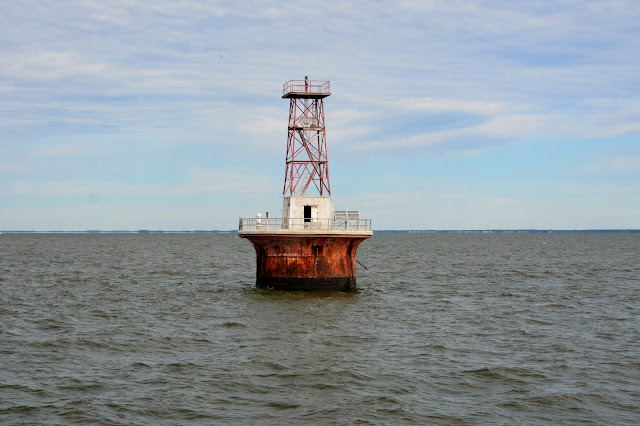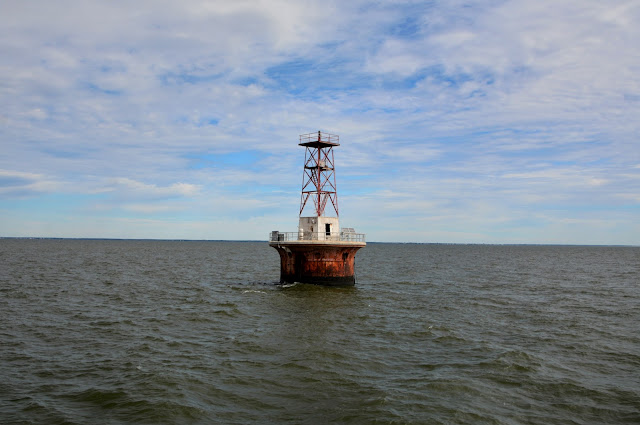The first lighthouse to mark Cross Ledge was built in the 1870s near the southern end of the submerged navigational hazard. Years later, the Lighthouse Board decided that maritime traffic would be better served with a lighthouse positioned just over two miles northwest of the original Cross Ledge Lighthouse on an “elbow” of the ledge that protruded toward the main shipping channel, and Congress appropriated $75,000 on April 28, 1904, for a lighthouse and fog signal at Elbow of Cross Ledge. After no initial satisfactory submissions were received, the project had to be advertised again. The second round of bids was opened on December 18, 1905, resulting in a contract being signed less than two months later with the lowest bidder. Work on the foundation soon began, and the completed metalwork was delivered to the former lighthouse depot on Christiana River near Wilmington, Delaware by January 1907. Recognizing the remaining funds were insufficient to complete Elbow of Cross Ledge Lighthouse, the Lighthouse Board petitioned Congress for an additional $21,500, which was granted on May 27, 1908. The lighthouse superstructure consisted of a two-story octagonal dwelling built of brick for the keepers, topped by an octagonal, iron watchroom and a circular, helical-bar lantern room. A brass spindle with a platinum tip was put in place as a lightning rod atop the spherical ventilator ball on the lantern room, and a copper ribbon ran from the rod to the iron veranda, which surrounded the first story of the dwelling. The first floor of the lighthouse featured an entrance hall, kitchen, and dining room, while two bedrooms and a bathroom were found on the second floor, and the third story contained a third bedroom and the watchroom. A fourth-order Barbier, Benard and Turenne Fresnel lens with four panels was installed in the lantern room. The three keepers from Cross Ledge Lighthouse, Ethan A. Duffield, Julian Bacon, and Harry W. Sheppard, were transferred to Elbow of Cross Ledge Lighthouse, where the official light was first exhibited by them on February 1, 1910. A 2,000-pound fog bell, cast by the McShane Bell Foundry Co. of Baltimore using 78% copper and 22% tin, was mounted on the deck beneath the veranda, where it was struck every fifteen seconds by a No. 3 fog-bell striker when visibility was limited. The station was electrified in 1932 through the installation of a duplicate set of 800-watt lighting plants. A 32-volt, 250-watt electric lamp was placed inside the station’s fourth-order lens at this time, and a Tyfon air horn replaced the fog bell. While the keepers may have kept the lighthouse neat, they were not necessarily fond of their place of residence. In an article included the Philadelphia Evening Bulletin, Francis A. Massey, office-in-charge of the Lewes Coast Guard Station, stated “the boys on Elbow of Cross Ledge lost plenty of sleep on foggy nights” as several vessels had struck the lighthouse with glancing blows while trying to navigate the bay in pea soup fog.On October 20, 1953, the Steel Apprentice was inbound to Philadelphia from the Middle East. The giant ore ship was operating practically blind as a thick fog blanketed the bay and the vessel’s radar was out of commission. After passing Miah Maull Lighthouse, the Steel Apprentice set a course toward the elbow, its next turning point. The ship was traveling at a low speed watching for channel markers, when Elbow of Cross Ledge Lighthouse suddenly appeared directly in its path. There wasn’t even time to brace for the impact, which toppled the upper two-thirds of the lighthouse into the bay and heavily damaged the caisson. Certainly if keepers had still been stationed at the lighthouse there would have been at least one fatality. The previously damaged lighthouse was now partially destroyed, and Mack Construction of Cape May was paid $100,000 to complete the demolition and install a skeleton tower atop the caisson foundation. Today, the red tower, which stands on a white base, supports a solar beacon.
Located about 26 miles up the Delaware Bay from Cape May and five miles offshore from Fortescue.
GPS: Latitude: 39.182226, Longitude: -75.268443














No comments:
Post a Comment